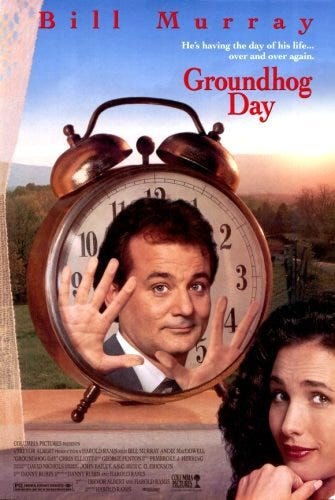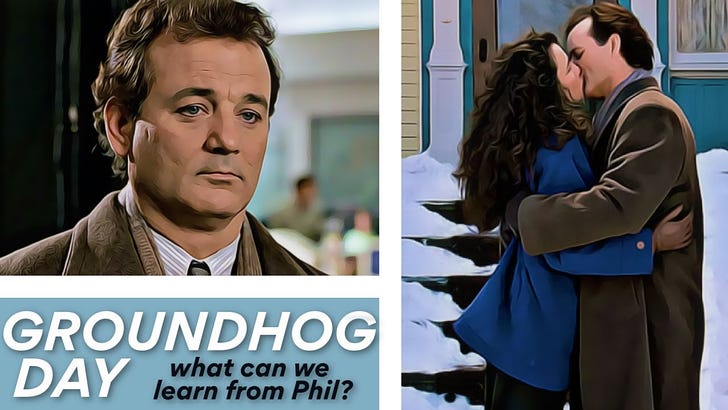Tales from the jar side: The loneliness of isolation, My anniversary, and Updating my GitHub Profile
During a pandemic, every day feels like Groundhog Day
Welcome to Tales from the jar side, the Kousen IT newsletter, for the week of October 4 - 11, 2020. This week I taught my regular Spring and Spring Boot course on the O’Reilly Learning Platform, then a course on Java Testing with JUnit 5 and Mockito as an NFJS Virtual Workshop, and then my What’s New In Java course on the O’Reilly Learning Platform.
World Mental Health Day
Saturday, October 10, was designated World Mental Health Day by the World Health Organization. In honor of that, I want to share this YouTube video I saw this week:
The creator is from a channel called My Little Thought Tree, which an unfortunate name, but don’t let that dissuade you from the quality his insight. From his playlist on Good Will Hunting I learned that he’s a professional therapist, which probably explains his reluctance to give his real name, but also gives you a sense of his perspective.
I’ve seen the movie Groundhog Day a countably infinite number of times and can quote entire scenes from memory. I’ve also read several commentaries on the movie, which range from Buddhist interpretations to analogies to purgatory to metaphors for redemption through good deeds. It’s hard to find something new to say about the movie that I haven’t at least heard before, but this video manages to do so.

In the wildly unlikely event you haven’t seen the movie and know nothing about it, let me give a very brief summary: Phil Connors is a Pittsburgh weatherman who gets stuck in Punxsutawney, PA, forced to repeat a single day over and over, forever. Over time he transforms himself from a hopeless narcissist into a caring person, which lets him escape the time loop. That may sound like spoilers, but it’s really all about the journey.
The take in the video above focuses on Phil’s inability to experience happiness. In the beginning of the movie he rejects it from every person he encounters. I hadn’t thought about his situation in those terms, but it’s key. Every single person Phil interacts with is happy, a fact which Phil either belittles or ruthlessly exploits.
The video is worth watching in its entirety, but here are the main points:
The Phil Connors from the early part of the movie sees himself as better than everyone else, which he expresses as contempt and cynicism.
That pushes everyone away, isolating him from all real human connections.
As the days accumulate, the crushing despair of loneliness is what drives him toward extreme measures.
When even suicide doesn’t end the cycle (a bold choice by the film makers, if I may say so), he finally opens up to Rita about his situation. That gives him a single good day, doing almost nothing but sharing in her ability to delight in everyday things, thus experiencing the first feelings of joy he has had in a long, long time.
Interacting with her as a real person teaches him that forming actual connections with others — making their lives better — is the only way to relieve the pain, and ultimately to break the cycle.
Phil doesn’t learn to be a good person in order to escape the time loop. By the time he starts changing, he no longer believes escape is possible. Connecting with people, caring about them, and helping them, are all ways to deal with the unremitting horror of the endlessly repeated day.
As we go through this horribly mismanaged pandemic, with its enforced isolation, uncertainty, and fear, I’m reminded that connecting to others is one way to endure. I’m so glad I have courses to teach, which I’d like to believe help other people. I’m glad I have this newsletter, as another way to connect to people. Above all, I’m glad I have my wife with me during this crisis. I honestly don’t know what I would have done if I’d had to go through this all alone.
(If you like the video above, check out his series on a Therapist Explains Good Will Hunting. And yes, full disclosure, I did decide to support him on Patreon. I mean, how could I not?)
Speaking of my wife…
Last Wednesday we turned 30. We were married on October 7, 1990, which is very convenient, because getting married in a year that ends in a zero makes it easy to determine how long we’ve been married.
Thirty years sounds like a lot, and somehow feels like an inadequate description. It’s a lifetime spent together, but we’ve both changed so much over the years (especially me, to be honest) that we still spend time getting to know each other. Since I’m 58 years old, I can now say I’ve been married longer than I haven’t. Yet all that doesn’t express the significance of the most important relationship of my life.
Maybe it’s because we’re not dramatic, despite meeting during a community theater show (Brigadoon, if you must know, which still makes me roll my eyes). Probably the best word that describes us is comfortable. All these years later, an ideal evening for us is a quiet dinner followed by sitting on the couch catching up on some old TV series (currently Star Trek: Enterprise) while holding hands.
The typical joke would be to say, “and they said it wouldn’t last.” Nobody ever said that about us. From the first day we told people we were together, the reaction was always, “yeah, that fits.” And it still does, all these years later.
Back in the summer of 2017, I went into a recording studio with a couple of karaoke tracks and put together this video for her birthday:
I hope you like it. I still do, despite the fact that she stays pretty much the same while you watch me progressively lose more and more of my hair. Sigh.
GitHub Profile
This week I followed the example of my friend Dan Vega and revamped my GitHub profile page to include my latest blog posts and my most recent newsletters, as well as a badge showing the most used languages in my repositories. If you look at my root repository, you’ll see a nested folder called .github/workflows, inside which you’ll find files called blog-post-workflow.yml and newsletter-workflow.yml. Here is the newsletter one:

Those files are based on a GitHub Action created by Gautam Krishnar, who describes how to use it in detail on his page. The actions work with a Markdown file called README.md, which includes the tags replaced by the actions. Feel free to borrow mine as an example, just as I “reused” Dan’s. (Thanks, Dan, both for the idea and the examples.)
Finally, I want to mention that my good friend Tim Berglund (see his Twitter feed) has been diagnosed with COVID-19. I met Tim through the No Fluff, Just Stuff conference series, and we’ve stayed connected ever since. He’s one of the best people I know, and I’ve always liked and admired him. He’s a Senior Director of Developer Advocacy at Confluent, but he’s so much more than his job, both as a professional and as a person.
I wish all the best to him and to his family.
Last week:
Spring and Spring Boot, on the O’Reilly Learning Platform
JUnit 5 and Mockito, an NFJS Virtual Workshop
What’s New In Java, on the O’Reilly Learning Platform
This week:
Kotlin Basics And Beyond, an NFJS Virtual Workshop
Functional Programming in Java, on the O’Reilly Learning Platform
A few other interesting meetings that I might talk about next week.




